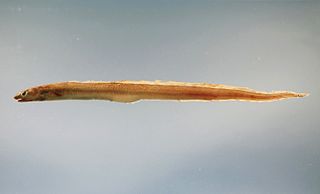
Conger is a genus of marine congrid eels. It includes some of the largest types of eels, ranging up to 2 m (6 ft) or more in length, in the case of the European conger. Large congers have often been observed by divers during the day in parts of the Mediterranean Sea, and both European and American congers are sometimes caught by fishermen along the European and North American Atlantic coasts.

The Congridae are the family of conger and garden eels. Congers are valuable and often large food fishes, while garden eels live in colonies, all protruding from the sea floor after the manner of plants in a garden. The family includes over 220 species in 32 genera.
Gnathophis is a genus of marine congrid eels.

Ariosoma is a genus of marine congrid eels.
Bathycongrus is a genus of eels in the family Congridae.
Parabathymyrus is a genus of eels in the family Congridae.
Hoplunnis is a genus of eels in the duckbill eel family Nettastomatidae. It currently contains the following species:

The Congrinae are a subfamily of eels in the family Congridae.
The flapnose conger is an eel in the family Congridae. It was described by David G. Smith and Robert H. Kanazawa in 1977. It is a tropical, marine eel which is known from French Guiana, in the western central Atlantic Ocean. It is known to dwell at a depth of 210 metres.
The Bullish conger is an eel in the family Congridae. It was described by David G. Smith and Robert H. Kanazawa in 1977, originally under the genus Rhechias. It is a marine, deep water-dwelling eel which is known from the Gulf of Mexico to the Amazon, in the western Atlantic Ocean. It dwells at a depth range of 366–475 meters. Males can reach a maximum total length of 39.5 centimeters.
Bathycongrus polyporus is an eel in the family Congridae. It was described by David G. Smith and Robert H. Kanazawa in 1977, originally under the genus Rhechias. It is a marine, deep water-dwelling eel which is known from the Straits of Florida and the northern coast of Cuba, in the western central Atlantic Ocean. It dwells at a depth range of 439–549 meters. Males can reach a maximum total length of 43 centimeters.
The manytooth conger, also known as the manytooth conger eel or simply the conger eel, is an eel in the family Congridae. It was described by Robert H. Kanazawa in 1958. It is a tropical, marine eel which is known from the western Atlantic Ocean, including the United States, Bermuda, the Antilles, the western Caribbean, and Brazil. It dwells at a depth range of 3–55 meters, and leads a benthic lifestyle, inhabiting rocky regions and coral reefs. Males can reach a maximum total length of 100 centimeters, but more commonly reach a TL of 80 cm.
Gnathophis bathytopos, the blackgut conger, is an eel in the family Congridae. It was described by David G. Smith and Robert H. Kanazawa in 1977. It is a marine, deep water-dwelling eel which is known from the Straits of Florida, USA, and the southeastern Gulf of Mexico, in the western Atlantic Ocean. It dwells at a depth range of 180–370 meters. Males can reach a maximum total length of 35 cm.
Gnathophis bracheatopos, the longeye conger, is an eel in the family Congridae. It was described by David G. Smith and Robert H. Kanazawa in 1977. It is a tropical, marine eel which is known from the United States and the eastern Gulf of Mexico, in the western Atlantic Ocean. It dwells at a depth range of 55–110 meters. Males can reach a maximum total length of 35 centimeters.
Gnathophis tritos is an eel in the family Congridae. It was described by David G. Smith and Robert H. Kanazawa in 1977. It is a marine, deep water-dwelling eel which is known from the Straits of Florida, in the western central Atlantic Ocean. It dwells at a depth range of 458–567 meters.
Japonoconger caribbeus is an eel in the family Congridae. It was described by David G. Smith and Robert H. Kanazawa in 1977. It is a marine, deep water-dwelling eel which is known only from the Caribbean Sea, in the western central Atlantic Ocean. It dwells at a depth range of 329–576 m (1,079–1,890 ft). Males can reach a maximum total length of 50.2 cm (19.8 in).
Xenomystax atrarius, the deepwater conger or twinpored eel, is an eel in the family Congridae. It was described by Charles Henry Gilbert in 1891. It is a marine, deep water-dwelling eel which is known from southern Canada to Chile, in the eastern Pacific Ocean. It dwells at a depth range of 152–1,050 metres (499–3,445 ft). Males can reach a maximum total length of 100 centimetres (39 in).
Xenomystax austrinus is an eel in the family Congridae. It was described by David G. Smith and Robert H. Kanazawa in 1989. It is a marine, deep water-dwelling eel which is known from the western central Atlantic Ocean. It is known to dwell at a depth range of 458 to 732 meters.
Xenomystax bidentatus is an eel in the family Congridae. It was described by Earl Desmond Reid in 1940. It is a marine, tropical eel which is known from northern South America, in the western central Atlantic Ocean. It is known to dwell at a depth range of 494 to 604 meters.

The bristletooth conger is an eel in the family Congridae. It was described by David G. Smith and Robert H. Kanazawa in 1989. It is a marine, deep water–dwelling eel which is known from the western Atlantic Ocean, including northeastern Florida, U.S.A.; the Gulf of Mexico, the Amazon River, the Bahamas and the West Indies. It dwells at a depth range of 140–825 metres (459–2,707 ft). Males can reach a maximum total length of 87.6 centimetres (34.5 in).





